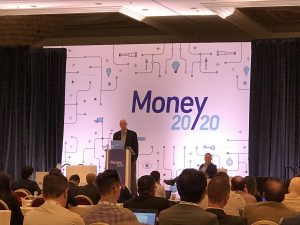It was an eventful Day One at the Money20/20 conference, with news to share on how FIDO Authentication has quickly become the go-to standard for secure and easy commerce. Here are the latest developments from yesterday:
Google Demonstrates Seamless Payments with W3C and FIDO Standards
There is no doubt that friction still exists in online and mobile payments, despite the industry’s best efforts to optimize the experience. Payment processes are inconsistent and filling in forms on small screens is a hassle, as is needing a separate, complex password across sites. Yesterday, Google’s Christiaan Brand took the stage with FIDO Alliance Executive Director Brett McDowell to demonstrate exciting upcoming Android capabilities utilizing World Wide Web Consortium (W3C) and FIDO standards to enable biometric-based payment and authentication on the web.

Brand’s demo illustrated how two soon-to-be-published standards, W3C’s Web Authentication and Web Payments (the former based on FIDO2 specifications), will be implemented on Android platforms. First, it allows online shoppers to checkout without having to fill in any forms – payment and shipping information is automatically filled in (Web Payments standard). Then, the shopper can simply authenticate themselves via fingerprint (Web Authentication standard) and the payment is authorized. The result is a significantly faster online payments experience with no passwords and no form filling. It’s also a great example of how the two standards work well when implemented together, as Google plans for Android.
Want to see the demo in action? Check out this video!

Bank of America to use FIDO-Certified Intel Technology to Expand Biometric Authentication Offering
Bank of America announced that it will begin implementing Intel’s FIDO® Certified Online Connect technology in its online banking platform.
The solution combines Intel Online Connect and Intel Software Guard Extension technology with Bank of America’s existing FIDO Certified authentication infrastructure to deliver an improved user experience with fingerprint biometrics that use public key cryptography instead of passwords. Because of its use of FIDO specifications, Intel’s technology requires that the biometric data is stored only on the user’s device and not on a public server or cloud, which provides an additional level of protection to Bank of America customers.
This news showcases Bank of America’s ongoing commitment to online banking security and convenience, by first adopting biometric-based FIDO authentication for mobile banking and now expanding that today to PC’s using FIDO Certified Intel technology. Bank of America can be confident knowing that its best-of-breed user experiences are backed by FIDO’s cryptographic security and that a customer’s biometric data never leaves their device.
Visit the FIDO Pavilion
If you’re attending Money20/20 2017, visit us on the show floor at Booth 1465. Our participating members – Aware, Inc.; FaceTec; Feitian; Nok Nok Labs; Raonsecure Co Ltd; StrongAuth; and TRUXTUN Capital – have some great demos and are ready to engage with you on how they’re changing the high-water mark for authentication in the payments ecosystem.

